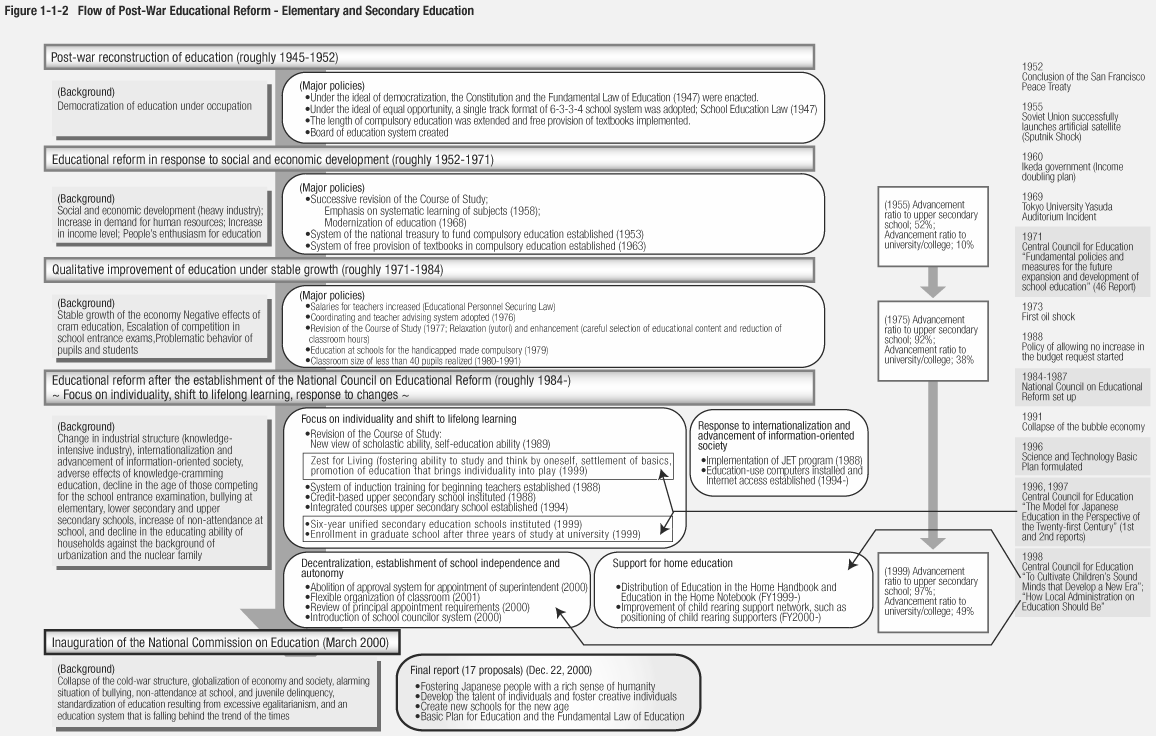| Home > Policy > White Paper, Notice, Announcement > White Paper > Japanese Government Policies in Education, Culture, Sports, Science and Technology 2002 >Chapter1 Section1.3 | ||
From around the 1970s, while problems of children, such as school violence, bullying and juvenile delinquency, became major social concerns, the question of how to ease the excessive competition in entrance examination became a major educational issue. For this reason, the National Council on Educational Reform was established under the Prime Minister in 1984 to discuss education as a whole. The National Council on Educational Reform submitted a report on educational reform calling for the basic ideas of the principle of respect for the individual, shift to a lifelong learning society, and response to new eras and changes in society. Based on the report, various reforms were carried out.
For example, educational contents and methods were improved, including the revision of the Course of Study to provide education in accordance with the characteristics of each child, and to foster the ability to study on one's own initiative in a lifelong learning society. Also, team teaching (cooperative guidance by multiple number of teachers) has been introduced to promote fine-tuned education.
In order to promote diversified education that would satisfy diversified demands from students, new types of upper secondary schools were established, such as credit-based and integrated courses.
In response to the development of internationalization and with a view to cultivating Japanese people who can live successfully in international society, measures to improve English and other foreign language education were implemented along with education to cultivate an attitude of appreciation for the culture and tradition of Japan. In response to the advancement of an information-oriented society, educational-use computers began to be installed around this time.
The basic philosophy of the educational reform aims at providing education by giving due consideration to the role of school in a lifelong learning society, respecting the individuality of each child, and responding to changes to society and the times, such as internationalization and the advancement of information-oriented society. The educational reform's basic philosophy has been consistently applied in educational reform and improvements implemented after the report of the National Council on Educational Reform.
"The Model for Japanese Education in the Perspective of the Twenty-first Century," a report submitted by the Central Council for Education in 1996, proposed that future education should aim for nurturing a "Zest for Living." This has made fostering rich humanity by nurturing the ability to find problems, learn, and act by oneself in a rapidly changing society, a major objective of education.
In 1999, unified lower and upper secondary education schools were instituted. This is designed to further diversify secondary education by focusing on diversified demands of students.
With a view to enhancing the function of boards of education and promoting educational administration in accordance with local characteristics, boards of education were revitalized by devising a method to appoint board members and improving publicity and public hearing activities of boards of education. The decentralization of educational administration was promoted by such means as abolishing the approval requirements of the Ministry of Education, Science, Sports and Culture and Prefectural Board of Education for the appointment of a superintendent.

| Back To Top | MEXT HOME |